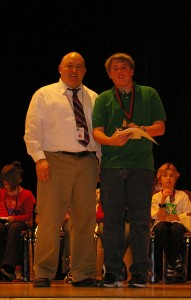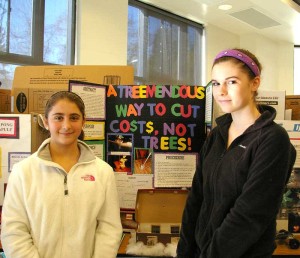
Eighth graders Sam Ferguson and Ani Jason stand next to their project that explores how trees outside of a house can provide shade and save money in the summer. The pair finished second in the grades 6-8 team category.
Participation and excitement expanding for schools’ science showcase
By Kyle Corrazza, Staff Writer, The Times
CALN – Have you ever wondered what color appears the most in a package of M&M’s? Whether or not people can actually perceive the taste difference in regular versus fat-free foods? How you can keep your house cool during the summer to cut down on energy costs?

First graders Bryce Kerrigan and Evan Byerley stand next to CASD Director of Science Denim Kurtzhals on the 9/10 Center state. Kerrigan and Byerly tied for first first grade.
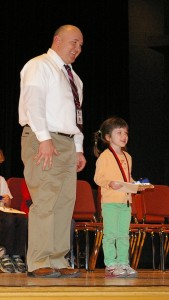
Kindergartener Elliana Wayland stands in front of the auditorium. Wayland was the only one in her grade who completed a project.
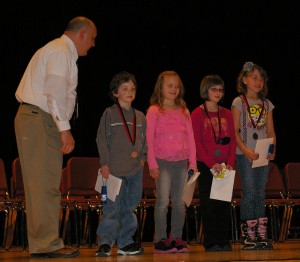
The second graders share the spotlight. Rebekah Hallenbeck received an honorable mention, and Molly Atwell, Scarlett Shaeffer, and Peter Wayland finished first, second, and third, respectively.
From big questions to small curiosities, weird wonders to useful practices, students presented a wide range of projects on Saturday at Coatesville Area School District’s 2013 Science Fair. Among their findings, brown, yes, and a tree near the house to create shade were some of the answers to the dilemmas that the students explored.
Held in the 9/10 Center cafeteria, students from kindergarten to 12th grade produced a total of 161 projects, up from last year’s 141 and more than double the previous year’s 67.
“Thank you to all the administrators, teachers that promoted the fair, and students for willingness to compete,” said district Coordinator of Science Denim Kurtzhals. “I was blown away at the complexity of the projects.”
Through complex research, many projects offered simple solutions for everyday life. For example, Sam Ferguson and Ani Jason, who placed second in the middle school teams category, measured internal house temperatures and energy usage to come to the conclusion that planting a tree in your yard will save money and help the environment and require little manual maintenance.
“We thought it would be useful to do something with natural resources because we’re going to have to use them more in the future,” said Jason.
But finding solutions was only one of many payoffs that students gained from participating.
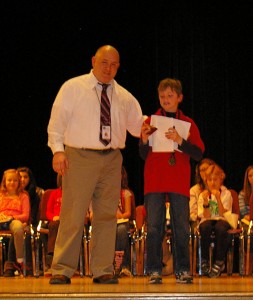
Third grader Josh Kerrigan’s project on heat conduction earned him a the best in show spot for the elementary level.
High school winner, junior Joshua Mensah, found that his hypothesis on the most effective way to preserve a clarinet reed was incorrect. Still, conducting the research benefited him in ways that go beyond his affinity for music.
“I may not use science [after high school], but what you learn you can use in other activities,” said Mensah, who admitted that science is not his favorite subject. “Now I see how I can use the scientific method to analyze situations, which will help me for law school.”
Although the best researchers in each grade did receive recognition and prizes, such as Caln Roller Rink parties or YMCA memberships, the day was hardly about competition.
“Some of the projects dealt with present and future real world problems; there were a lot of out-of-the-box ideas,” said Kurtzhals. “These students are future leaders.”
In effective education, students do not just learn facts and processes—they also learn how to learn. Just as the formula on a physics chalkboard affects objects outside of the classroom, these experiments will have given students experiences that will help them in ways that far outreach a single science project.
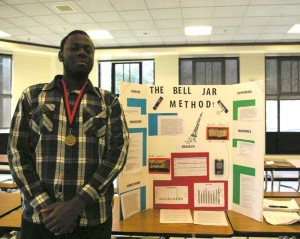
Junior Joshua Mensah poses next to his project where he tried to extend the life of a clarinet reed by placing it in a humid jar. Even though his hypothesis did not work out, his research and methods earned him first place out of the juniors and seniors. “I actually don’t like science, but I combined it with something I love,” said the marching band section leader.
Individual winners:
Kindergarten – Elliana Waylan
Grade 1 – tie, Evan Byerley and Bryce Kerrigan
Grade 2 – Molly Atwell
Grade 3 – Joshua Kerrigan*
Grade 4 – Allison Carling
Grade 5 – Morgan Ernst
Grade 6 – Sean Wolstenholme
Grade 7 – William Ernst
Grade 8 – Ashley Mendenhall*
Grade 9 – Joshua Bream*
Grades 10-12 – Joshua Mensah
*Denotes best in show
Team winners:
Grades 3-5 – Vicky Railing and Lauren Morgan
Grades 6-8 – Stephanie Banks and Karaline Sperow
Grades 9-12 – Megan Finney and Isaiah Robertson

